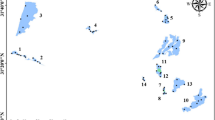Abstract
A quantitative study, based on monthly samples taken by divers with 0.1m2 quadrats, was conducted on a benthic community settling coarse sediments in an area exposed to strong water currents.
The richness of the community was high both in terms of biomass (270±107 g m−2 in ash-free dry weight) and diversity (ten zoologicals groups for a total of 98 species). Three suspension feeding species were dominant: Ophiothrix fragilis, Urticina felina and Alcyonium digitatum accounted for more than 95% of the total biomass at all sampling periods.
Spatial heterogeneity analysis confirmed the role of these three dominant species. Heterogeneity revealed at a scale of 0.1 m2 by dendrograms (qualitative similarity index) or by Factor Correspondence Analysis (FCA) (on biomasses) was due to the strong dispersion of rare species.
The influence of the observation scale was visualised by building Rank-Frequency Diagrams using progressively aggregated replicates. The distribution of relative biomasses and the rank of the dominant species always stabilized at scale of 0.4 or 0.5 m2.
The three dominant species were overdispersed at a scale of 0.1 m2 compared with a Poisson distribution. Spatial competition among the three species was suggested by their dispersion in the plane of the FCA. Calculation of a multiple linear regression (at the scale of 0.8 m2) showed negative relationships among these dominant species.
Temporal homogeneity was indicated (at a scale of 0.8 m2) by dendrograms of species similarities among samples and by FCA performed on total biomasses.
Similar content being viewed by others
References
Anonymous, 1968. Courants de marée dans la Manche et sur les côtes françaises de l'Atlantique. Service hydrographique de la Marine, Imprimerie Nationale, Paris.
Anonymous, 1986. Fifth report of the Benthos Ecology Working Group. ICES, Ostende, 12–15 May, CM, L: 27, 33 pp.
Boudouresque, C. F., 1971. Méthodes d'étude qualitative et quantitative du benthos (en particulier du phytobenthos). Téthys 3: 79–104.
Cabioch, L. & R. Glaçon, 1975. Distribution des peuplements benthiques en Manche Orientale, de la Baie de Somme au Pas-de-Calais. C.r. Acad. Sci., Paris, 285, série D: 491–494.
Crisp, D.., 1984. Energy flow measurements. Chapter 9,pp. 284–372 in N. A. Holme & A. .McIntyre (eds) Methods for the study of marine benthos, International Biological Programme Handbook No 16, 2nd edn. Blackwell Scientific Publications, Oxford, 387 pp.
Dauvin, J. C., 1984. Dynamique d'écosystèmes macrobenthiques des fonds sédimentaires de la Baie de Morlaix et leur perturbation par les hydraucarbures de l'Amoco Cadiz, Thèse doc. d'Etat, Univ. Paris VI, 498 pp. + 193 pp. d'Annexes.
Davoult, D., 1990. Biofaciès et structure trophique du peuplement des cailloutis du Pas-de-Calais (France). Oceanol. Acta 13: 335–348.
Davoult, D., 1992. Choix raisonné de l'effort d'échantillonage lors de l'étude spatiale de peuplements macrobenthiques. C. r. Acad. Sci., Paris, t. 315, série III: 279–285.
Davoult, D., F. Gounin & A. Richard, 1990a. Dynamique et reproduction de la population d' Ophiothrix fragilis du détroit du Pas-de-Calais (France). J. exp. mar. Biol. Ecol., 138: 201–216.
Davoult, D., F. Gounin & A. Richard, 1990b. Ecologie des bancs d'Ophiothrix fragilis va pentaphyllum du détroit du Pas-de-Calais (France). In: Dubois, Lahaye & Jangoux (eds), Echinoderm Research, De Ridder, Balkema, Rotterdam: 159–164.
Davoult, D., F. Gounin & M. A. Janquin, 1991. Ammonium excretion by the ophiurid Ophiothrix fragilis as a function of season and tide. Mar. Biol. 111: 425–429.
Elliot, J. M., 1977. Some methods for the statistical analysis of samples of benthic invertebrates. Scientific Publications, Freshwater Biological Association, 25 (2nd edn), 156 pp.
Gamble, J. C., 1984. Diving. Chapter 5, pp. 99–139 in N. A. Holme & A. D. McIntyre (eds), Methods for the study of marine benthos, International Biological Programme Handbook No 16, 2nd edn. Blackwell Scientific Publications, Oxford, 387 pp.
Green, R. H., 1979. Sampling design and statistical methods for environmental biologists. John Wiley & Sons, New York, 257 pp.
Larsonneur, C., P. Bouysse & J. P. Auffret, 1982. The superficial sediments of the English Channel and its western approaches. Sedimentology 29: 851–864.
Legendre, L. & P. Legendre, 1984. Ecologie numérique 2: la structure des données écologiques. Collection d'écologie 12, Ed. Masson, 335 pp.
McIntyre, A. D., J. M. Elliot & D. V. Ellis, 1984. Introduction: design of sampling programmes. Chapter 1, pp. 1–26 in N. A. Holme & A. D. MacIntyre (eds), Methods for the study of marine benthos, International Biological Programme Handbook No 16, 2nd Ed. Blackwell Scientific Publications, Oxford, 387 pp.
Nesis, K. N., 1970. Biocoenoses and biomass of the benthos of the Newfoundland-Labrador region. Fish. Res. Bd. Canada, Trans. Ser. No 1375, 75 pp.
Plante, R. & P. Le Loeuff, 1982. Le benthos marin et les stratégies d'échantillonnage. In S. Frontier (ed.), Stratégies d'échantillonage en écologie. Masson Paris.
Prygiel, J., D. Davoult, J. M. Dewarumez, R. Glaçon & A. Richard, 1988. Description et richesse des peuplements benthiques de la partie française de la Mer du Nord. C. r. Acad. Sci., Paris 306 (III): 5–10.
Steimle, F. W., 1985. Biomass and estimated productivity of the benthic macrofauna in the New York Bight: a dressed coastal area. Estuar. coast. shelf. Sci. 21: 539–554.
Taylor, L. R., 1961. Aggregation, variance and the mean. Nature, London, 189: 732–735.
Weinberg, S., 1978. The minimal area problem in invertebrate communities of mediterranean rocky substrata. Mar. Biol. 49: 33–40.
Author information
Authors and Affiliations
Rights and permissions
About this article
Cite this article
Migné, A., Davoult, D. Multi-scale heterogeneity in a macrobenthic epifauna community. Hydrobiologia 300, 375–381 (1995). https://doi.org/10.1007/BF00024478
Issue Date:
DOI: https://doi.org/10.1007/BF00024478




